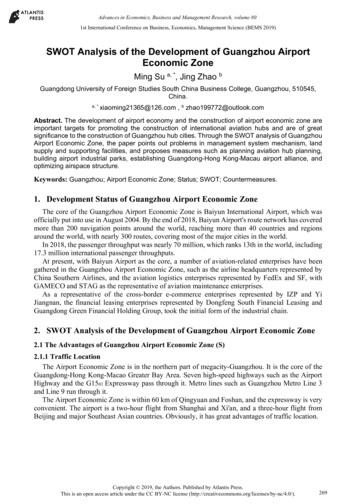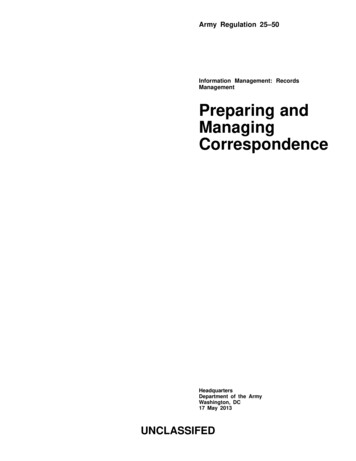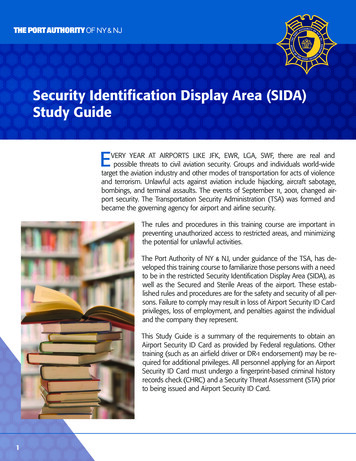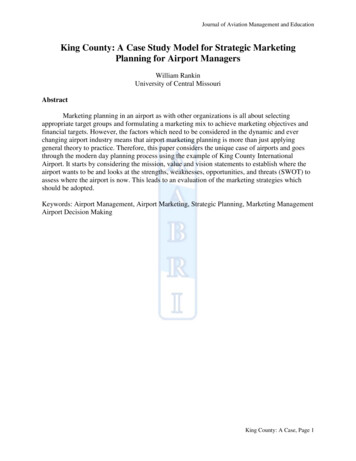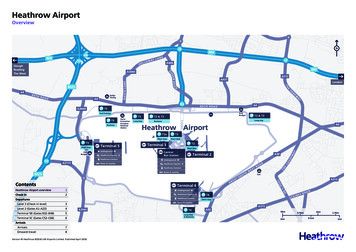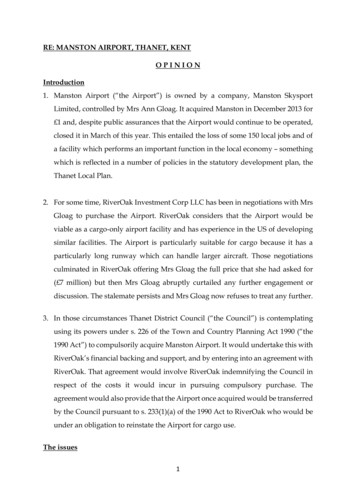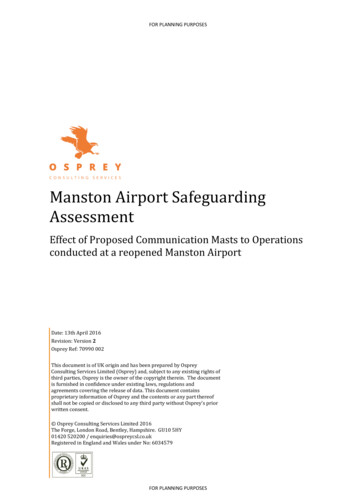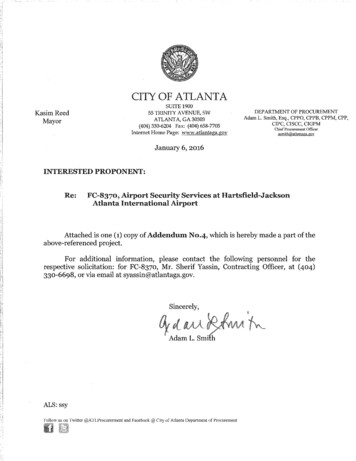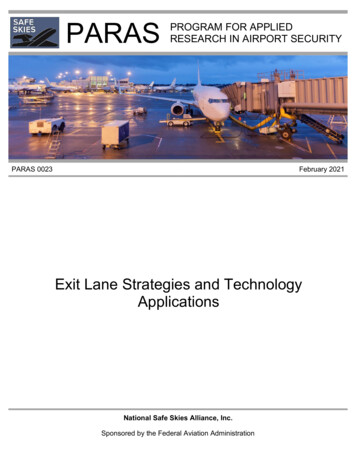
Transcription
PARASPROGRAM FOR APPLIEDRESEARCH IN AIRPORT SECURITYPARAS 0023February 2021Exit Lane Strategies and TechnologyApplicationsNational Safe Skies Alliance, Inc.Sponsored by the Federal Aviation Administration
PARAS 0023February 2021Gloria BenderAndy EntrekinJessica GaffordTransSolutionsFort Worth, TXChristian SamlaskaSeattle, Washington 2021 National Safe Skies Alliance, Inc. All rights reserved.COPYRIGHT INFORMATIONAuthors herein are responsible for the authenticity of their materials and for obtaining written permissions frompublishers or persons who own the copyright to any previously published or copyrighted material used herein.National Safe Skies Alliance, Inc. (Safe Skies) grants permission to reproduce material in this publication forclassroom and not-for-profit purposes. Permission is given with the understanding that none of the material will beused to imply Safe Skies or Federal Aviation Administration (FAA) endorsement of a particular product, method, orpractice. It is expected that those reproducing the material in this document for educational and not-for-profit useswill give appropriate acknowledgment of the source of any reprinted or reproduced material. For other uses of thematerial, request permission from Safe Skies.NOTICEThe project that is the subject of this report was a part of the Program for Applied Research in Airport Security(PARAS), managed by Safe Skies and funded by the FAA.The members of the technical panel selected to monitor this project and to review this report were chosen for theirspecial competencies and with regard for appropriate balance. The report was reviewed by the technical panel andaccepted for publication according to procedures established and overseen by Safe Skies.The opinions and conclusions expressed or implied in this report are those of the individuals or organizations whoperformed the research and are not necessarily those of Safe Skies or the FAA.Safe Skies and the FAA do not endorse products or manufacturers.Exit Lane Strategies and Technology Applicationsii
PARAS 0023February 2021NATIONAL SAFE SKIES ALLIANCE, INC.National Safe Skies Alliance (Safe Skies) is a non-profit organization that works with airports, government, andindustry to maintain a safe and effective aviation security system. Safe Skies’ core services focus on helping airportoperators make informed decisions about their perimeter and access control security.Through the ASSIST (Airport Security Systems Integrated Support Testing) Program, Safe Skies conductsindependent, impartial evaluations of security equipment, systems, and processes at airports throughout the nation.Individual airports use the results to make informed decisions when deploying security technologies and procedures.Through the POST (Performance and Operational System Testing) Program, Safe Skies conducts long-termevaluations of airport-owned equipment to track and document a device or system’s performance continuously overits life cycle.Through PARAS (Program for Applied Research in Airport Security), Safe Skies provides a forum for addressingsecurity problems identified by the aviation industry.A Board of Directors and an Oversight Committee oversee Safe Skies’ policies and activities. The Board ofDirectors focuses on organizational structure and corporate development; the Oversight Committee approvesPARAS projects and sets ASSIST Program priorities.Funding for our programs is provided by the Federal Aviation Administration.Exit Lane Strategies and Technology Applicationsiii
PARAS 0023February 2021PROGRAM FOR APPLIED RESEARCH IN AIRPORT SECURITYThe Program for Applied Research in Airport Security (PARAS) is an industry-driven program that develops nearterm practical solutions to security problems faced by airport operators. PARAS is managed by Safe Skies, fundedby the Federal Aviation Administration, and modeled after the Airport Cooperative Research Program of theTransportation Research Board.Problem Statements, which are descriptions of security problems or questions for which airports need guidance, formthe basis of PARAS projects. Submitted Problem Statements are reviewed once yearly by the Safe Skies OversightCommittee, but can be submitted at any time.A project panel is formed for each funded problem statement. Project panel members are selected by Safe Skies, andgenerally consist of airport professionals, industry consultants, technology providers, and members of academia—allwith knowledge and experience specific to the project topic. The project panel develops a request of proposals basedon the Problem Statement, selects a contractor, provides technical guidance and counsel throughout the project, andreviews project deliverables.The results of PARAS projects are available to the industry at no charge. All deliverables are electronic, and mostcan be accessed directly at www.sskies.org/paras.PARAS PROGRAM OFFICERJessica Grizzle Safe Skies PARAS Program ManagerPARAS 0023 PROJECT PANELLori Anderson National Safe Skies AllianceEthan Barske Portland International AirportRyan Clements Easterwood AirportBryan Diekman Jacksonville Aviation AuthorityMark Inzana Denver International AirportBill Marrison National Safe Skies AllianceRichard Roth CTI ConsultingLisa Rousseau Port of SeattleChrister Wilkinson AECOMExit Lane Strategies and Technology Applicationsiv
PARAS 0023February 2021AUTHOR ACKNOWLEDGMENTSThe research conducted for this guidebook was performed under PARAS 0023 by TransSolutions, LLC.with the assistance of subject matter expert, Christian Samlaska.Gloria Bender of TransSolutions was the Principal Investigator for the project and primary author of theguidebook. Christian Samlaska, Andy Entrekin, and Jessica Gafford assisted with the research and datacollection.The research team would like to acknowledge the airports who took time out of their busy schedules tohelp make this document robust and useful to all sized airports. It is only through the support of airportsthat Safe Skies is able to continue to provide the aviation industry with valuable research on practicalairport-related topics. Finally, the research team wants to thank the panel of volunteers who lent theirexpertise and time to ensuring the guidebook would be useful and applicable.Exit Lane Strategies and Technology Applicationsv
February 2021PARAS 0023CONTENTSSUMMARYixPARAS ACRONYMSxABBREVIATIONS, ACRONYMS, INITIALISMS, AND SYMBOLSxiDEFINITIONSxiiSECTION 1: TION 2: DESIGN 1.2Deter32.1.3Detect42.1.4Alert and Alarm42.1.5Isolate52.2Life and Safety Codes and Accessibility62.3Redundancy7SECTION 3: TECHNOLOGY CONSIDERATIONS3.1Cameras and Video Analytics3.1.1Environmental Conditions3.1.2Video Analytics889103.2Access Control103.3Infrastructure Elements113.3.1Legacy EquipmentSECTION 4: TESTING AND TRAINING4.1Testing and Audits1213134.1.1Initial Testing134.1.2Calibration154.1.3Recurring ial Maintenance174.2.3Preventative Maintenance174.3SOPs and ASP UpdatesSECTION 5: OPERATIONAL CONSIDERATIONS5.1Configurations5.1.1Simple Door/Abrupt ExitExit Lane Strategies and Technology Applications17202020vi
February 2021PARAS 00235.1.2Corridors Less than 20 Feet205.1.3Corridors Greater than 20 Feet215.1.4Escalators and Stairs215.1.5Curves and Turns in the Corridor225.1.6Tall and Curved Ceilings225.1.7Co-located vs. Independent Exit Lanes225.2Throughput5.2.1Flow vs. Interlock23245.3Authorized Bypass255.4Signage and Wayfinding265.4.1Human Factors265.4.2Meeters and Greeters275.4.3Advertisements and Art285.4.4Frosted Glass285.4.5Courtesy Phones and Phone Numbers285.4.6Digital Wayfinding285.4.7Identification Markers295.5Maintenance and Reliability295.5.1Custodial Maintenance295.5.2Preventative Maintenance305.5.3Irregular Operations305.5.4Spare Parts30SECTION 6: CHOOSING A SOLUTION326.1.1Manned vs. Unmanned326.1.2Open Lane336.1.3Portal Systems346.1.4Simple Doors and Turnstiles346.1.5Sally Ports356.1.6Revolving Doors356.1.7Optical Turnstiles366.1.8Engineered Solutions36SECTION 7: PROCUREMENT CONSIDERATIONS7.1Formal Procurement Options (RFP/RFI/RFQ)7.1.1Informal Procurement Options3838397.2Return on Investment (ROI)447.3Funding457.4Project Timeline467.4.1Procurement PhaseExit Lane Strategies and Technology Applications46vii
February 2021PARAS 00237.4.2Deployment PhaseBIBLIOGRAPHY4749TABLES & FIGURESTable 1. Compatibility of Exit Lane Configurations with Technology Types32Table 2. Exit Lane Technology Capabilities and Compatibility32Table 3. Potential Impacts of Exit Lane Breach44Figure 1. Moiré Pattern10Figure 2. LEO Using the Exit Lane for Authorized Bypass11Figure 3. Example of a Simple Exit Door Layout20Figure 4. Sliding Exit Doors at the Bottom of Escalator21Figure 5. Example of Escalators Leading to Revolving Doors21Figure 6. Example of a Narrow Corridor with Doors at Either End21Figure 7. Example of a Wide Corridor with an Automatic Sliding Door21Figure 8. Example of a Short Corridor with a Curve22Figure 9. Flow Mode25Figure 10. Interlock Mode25Figure 11. Example of Lights Used to Identify Open Lanes26Figure 12. Example of Floor Signage27Figure 13. Example of a Height Measurement Sticker29Figure 14. Example of a Portal Style System34Figure 15. Example of a Sally Port Exit Lane35Figure 16. Example of a Revolving Door System35Figure 17. Example of Optical Barriers36Exit Lane Strategies and Technology Applicationsviii
PARAS 0023February 2021SUMMARYThere are currently numerous exit lane security solutions deployed at airports throughout the UnitedStates consisting of a mix of staffing, technology, and prefabricated devices.Many airports continue to maintain security guards as their primary method of exit lane protection andsecurity, but are interested in deploying more innovative solutions to improve the security posture of theairport and reduce costs. However, there has not been a consolidated source of information thatdiscusses available solutions and their capabilities, as well as the factors that airports should considerwhen choosing between them.Many elements need to be considered in the design, procurement, and deployment of a technology-basedexit lane protection system. This document is designed to assist airports in all stages of deploying exitlane solutions and includes discussions on: Planning considerations Operational factors Testing and auditing Maintenance requirements Training Potential configurations and layouts Compliance with health and safety codes Comparison and discussion of the capabilities of available technology typesExit Lane Strategies and Technology Applicationsix
PARAS 0023February 2021PARAS ACRONYMSACRPAirport Cooperative Research ProjectAIPAirport Improvement ProgramAOAAir Operations AreaARFFAircraft Rescue & FirefightingCCTVClosed Circuit TelevisionCEOChief Executive OfficerCFRCode of Federal RegulationsCOOChief Operating OfficerDHSDepartment of Homeland SecurityDOTDepartment of TransportationFAAFederal Aviation AdministrationFBIFederal Bureau of InvestigationFEMAFederal Emergency Management AgencyFSDFederal Security DirectorGPSGlobal Positioning SystemIEDImprovised Explosive DeviceIPInternet ProtocolITInformation TechnologyMOUMemorandum of UnderstandingRFPRequest for ProposalsROIReturn on InvestmentSIDASecurity Identification Display AreaSOPStandard Operating ProcedureSSISensitive Security InformationTSATransportation Security AdministrationExit Lane Strategies and Technology Applicationsx
PARAS 0023February 2021ABBREVIATIONS, ACRONYMS, INITIALISMS, AND SYMBOLSADAAmericans with Disabilities ActADPMAverage Day Peak MonthASPAirport Security ProgramELBCExit Lane Breach ControlFASTFind Airport Security TechnologiesKCMKnown Crew MemberLEOLaw Enforcement OfficerRFIRequest for InformationRFQRequest for QualificationsRFxRFI/RFQ/RFPSSCPSecurity Screening CheckpointExit Lane Strategies and Technology Applicationsxi
February 2021PARAS 0023DEFINITIONSBreachUnauthorized entry to a Sterile Area by an unscreened individual.Breach Control SystemIntegrated security devices that provide access control to preventwrong way movement through an airport exit lane by unauthorizedpersonnel or objects, which would allow access into the Sterile Area.Exit LaneThe passageway through which personnel and passengers exit theSterile Area of an airport terminal or concourse.Exit Lane Breach ControlDevices utilized at airport exit lanes that detect unauthorized access orattempted entry of people or objects into a Sterile Area.Exit Lane BreachUnauthorized access of people or objects into the Sterile Area via anexit lane.Public AreaAreas of an airport that do not require personnel or passengerscreening.Sterile AreaThat portion of an airport defined in the Airport Security Program thatprovides passengers access to boarding aircraft, and for which accessgenerally is controlled by the TSA, or by an aircraft operator underPart 1544 of 49 CFR Chapter XII or a foreign air carrier under Part1546 of said chapter, through the screening of persons and property.Exit Lane Strategies and Technology Applicationsxii
PARAS 0023February 2021SECTION 1: INTRODUCTIONThere are currently numerous exit lane solutions deployed at airports throughout the United States,consisting of a mix of staffing, technology, and prefabricated devices. In the years since TSA beganapproving the use of unmanned, automated exit lanes, the airport community has seen the long-termoperational benefits of upgrading their exit lane solutions and reducing the personnel resources needed.Many elements need to be considered in the design, procurement, and deployment of a technology-basedexit lane protection system. This document outlines and discusses many of the factors that airportsshould consider in exit lane system design and operation. It also examines why some systems havefailed to meet expectations, and provides cautionary tips for managing the pitfalls associated with exitlane management. Finally, this document contains helpful templates and worksheets to aid airportsecurity planners as they prepare to address exit lane protection.1.1PurposeMany airports continue to maintain guards as their primary method of exit lane protection and security,but are interested in deploying more innovative solutions to improve the security posture of the airportand reduce costs. However, there has not been a consolidated source of information that discussesavailable solutions and their capabilities, and the factors that airports should consider when choosingbetween them.The primary purpose of this document is to assist airports in researching, designing, procuring, andinstalling exit lane technology. This includes exit lane configuration discussions and the comparison anddiscussion of the capabilities of available technologies.1.2ScopeThis document consolidates the information, recommendations, solutions, and lessons learned foundduring an in-depth literature review and dozens of interviews with airport operators and vendors. Theproduct is designed to assist airports in all stages of deploying exit lane solutions, and includesdiscussions on: Planning considerations Operational factors Testing and auditing Maintenance requirements Training Potential configurations and layouts Compliance with health and safety codes Comparison and discussion of the capabilities of available technology types1.3NavigationThis document is designed to provide airports with a resource to help them research, design, procure,and deploy exit lane solutions. We recommend reading the document from beginning to end to fullyExit Lane Strategies and Technology Applications1
PARAS 0023February 2021understand the elements and factors necessary to help choose the solution that fits the airport’s needsand requirements.The first five sections are dedicated to researching exit lane solutions. These sections discuss exit lanesolution characteristics and capabilities, as well as factors airports should keep in mind when choosing asolution to fit their needs and requirements.Section 6 discusses the advantages and disadvantages of the available solution types. While it is notnecessary to have read the rest of the document, this section is the culmination of the previous sectionsand refers to several elements from those sections.Section 7 discusses procurement considerations, including formal and informal procurement options,ROI, funding, and project timelines.Exit Lane Strategies and Technology Applications2
PARAS 0023February 2021SECTION 2: DESIGN CHARACTERISTICSWhen researching exit lane solutions, airports should consider: How their exit lane configuration(s) would function most effectively with the various types ofsystems Which systems are the most cost effective for their operations Which solutions provide a reasonable ROI and have an acceptable life cycle Operational, maintenance, infrastructure requirements and issues Compliance with federal, state, and local requirements (Americans with Disabilities Act [ADA],Fire and Life Safety codes, SAFETY Act, etc.)2.1FunctionalitiesThe TSA has stated that the effectiveness of a technological solution should be based on thetechnology’s ability to detect, in real time, unauthorized persons enter a certain location; alert, in realtime, appropriate authorities of unauthorized ingress of persons or items; and prevent or mitigate abreach of the Sterile Area by unauthorized persons or items.In order to securely replace exit lane guard staff, a complete technology system should be able tomonitor for and deter potential breach attempts, detect the breaches when they occur, notify theauthorities to the breach, and isolate the person or object until the authorities can contain the situation.2.1.1 MonitorMonitoring includes observing the areas in and around an exit lane, with expanded means to identify andtrack a potential intruder. This also includes the ability to quickly capture images and video of thebreach incident to facilitate apprehension and, if warranted, prosecution.While human guards are the most common means for airports to monitor their exit lanes, CCTV,sensors, and video analytics are often used in conjunction with a guard or as a replacement. Somesystems have the capability to record and report events within the exit lane, which can be monitored bythe Communications or Security Operations Center for real-time resolution and reporting.Some systems can push video and photographs to mobile devices or remote computers, whichaccelerates the information flow to Law Enforcement Officers (LEO) and/or operational staff who areresponding to potential breaches. Standalone systems often enable the responder to access a computerterminal at the exit lane and view or print pictures. If the system is integrated with the Communicationsor Security Operations Center, the staff can then push the information out to the relevant authorities.2.1.2 DeterSystems designed for deterrence will warn an intruder or potential intruder by audible and/or visualmeans. The system alarms when triggered by specific events, such as venturing into predefined alarmzones. Warning situation examples include:Exit Lane Strategies and Technology Applications3
PARAS 0023February 2021 When an individual approaches the exit lane from the public area When an individual’s movements within the lane appear inconsistent with normal pedestrianflow (stopping, pausing, turning, or changing direction within the exit lane) When an individual does not respond an initial warning and proceeds into the exit lane from thepublic area (in this situation, an alert or alarm should also be issued)In addition, physical structures like doors, barriers, and contained corridors may have a greater deterrentfactor than open lanes with no overt security.2.1.3 DetectDetection identifies the improper entry into or movement within an exit lane, and passed or abandonedobjects. Typical capabilities include detecting the following: An individual who enters the exit lane from the public area An individual whose movements within the lane appear inconsistent with normal pedestrianflow, such as traveling in the wrong direction or within a moving crowd, or loitering in the areafor too long An unattended or abandoned object in the exit lane, or an object tossed into the lane from thepublic area An individual loitering in areas adjacent to the device Forced door movementMany technology solutions are deployed with these capabilities, which are typically performed usingsensors or video analytics; however, some systems cannot provide object detection if the object isthrown or moving at more than eight miles per hour.2.1.4 Alert and AlarmAlerts and alarms provide sensory feedback to both intruders and authorities. Alerts are meant to deterpotential intruders or indicate a potential issue. Alarms are meant to notify authorities that a triggeringevent has occurred (such as a breach) and a response is necessary. Which triggering events listed in theDeter and Detect sections above activate an alert or an alarm will depend on the airport’s protocols andthe solution deployed.Airports that use staff to control the exit lane typically have a podium within or near the lane at whichthe individual can monitor the exit lane’s camera feed(s). These usually have an alarm/breach button thatcan be pressed to notify airport security, the TSA, and LEOs, as well as a phone and/or radio tocommunicate. At some airports, pressing the breach button triggers an all-stop to the intra-airport railsystem. If exit lanes are monitored in a central Communications or Security Operations Center, an alarmcan be set up to notify and dispatch the responsible staff to intervene.Ideally, the exit lane solution should be capable of multiple alert and alarm levels. Airports utilizingsystems that have multiple alert and alarm levels see fewer breaches that may result in majordisturbances. The type of alert/alarm and triggering event for each should be determined by the airportwith input from stakeholders and the system vendor. It is not uncommon for the airport to reconfigurethese levels and triggering events multiple times before finding the best response level for the specificexit lane.Exit Lane Strategies and Technology Applications4
PARAS 0023February 2021Most airports with a technology solution use sensors or cameras to create invisible alert/alarm zones withinthe exit lane and extending into the public area. Typically, there are one to three alarm zones within thecorridor area and a pre-alarm/warning zone in the public space. Each of these zones is usually about 10feet long, but may vary depending on the corridor length and camera capabilities. Airports shouldconfigure zones to match the length of the exit lane corridor and the system’s capabilities.In a typical installation, the pre-alarm/warning zone cautions individuals in the area not to enter the exitlane from the public area. Some airports elect to have the pre-alarm/warning zone notify staff in theCommunications or Security Operations Center, but many only have a local verbal message meant toalert the person that they are too close to the exit lane. The next alert or alarm will trigger if theindividual continues the wrong way into the exit lane, and will then set off the alarm to theCommunications or Security Operations center so a LEO or operational staff can make an appropriateresponse.One airport interviewed for this guidebook has distinct carpet extending into public area. If anindividual steps within its boundaries, a restricted area warning alert is activated.Alerts and alarms can include an audible local alarm, a verbal message, flashing lights, camera call-ups,and/or a direct video feed and notifications to the Communication or Security Operations Center. Somesystems allow the notification to be sent to a local computer adjacent to the exit lane to notify theindividual staffing the lane. Some also have the ability to send the notification directly to specifiedusers’ cell phones or computers via email or text message.Local audible alerts and alarms are the most prevalent type used at United States airports. Physicallysmaller airports often choose to increase the alert/alarm volume to be heard across the entire terminal tonotify nearby personnel, LEOs, and TSOs to respond. Larger airports often set the alert/alarm volumelower to keep it localized to the exit lane and possibly a co-located checkpoint. Generally, these airportsintegrate the local audible alerts/alarms with an alert sent to the Communications/Security Operationscenter to dispatch LEOs.Some systems have the ability to program multiple verbal warning announcements that may correspondto the exit lane’s alert/alarm zones. While verbal warnings are good for redundancy, they are notrecommended for use on their own and should always be paired with audible and visual alarms. Thiswill allow airports to reach passengers with hearing or sight limitations, or passengers who do not speakthe language(s) of the verbal warning.False and nuisance alarms are common at airports, regardless of the solution deployed. A false alarm isone set off due to a system or technical error; a nuisance alarm is one that is set off unnecessarilybecause of passenger behaviors or environmental elements (e.g., a swinging bag or shadows generatedby lighting). Airports should be conscientious to design a system that results in a low false or nuisancealarm rate, since high levels may lead to personnel responding too slowly or ignoring the alarm.Nuisance and false alarms may also negatively affect the exiting queue and inconvenience passengers.However, airports need to configure the system carefully to ensure the overall sensitivity level is not solow that it misses valid alarm trigger events. More information on system calibration can be found inSection 4.1.2.2.1.5 IsolateIsolation is the use of physical impediments—the most common being doors—that limit passage orconfine an intruder to facilitate apprehension until a LEO, TSO, or operations/security staff member canExit Lane Strategies and Technology Applications5
PARAS 0023February 2021respond. True isolation consists of two layers: a prevention layer composed of a physical barrier at thelane exit to prevent unauthorized access into the lane from the public area, and a containment layercomposed of one or more physical barriers located elsewhere in the lane and/or in adjacent corridors.However, not all solutions offer both layers.Many systems that offer interlock capabilities, such as portal systems, have breach control doors on theSterile side of the exit lane that are programmed to close automatically when the system detects a breachattempt. The doors on the public side remain open for passengers, as well as the intruder, to exit into thepublic area.2.2Life and Safety Codes and AccessibilityTechnology systems must comply with all local, state, and federal regulations pertaining to safety, health,fire, ADA, etc. While most technology solutions are designed specifically to ensure they meet theserequirements, European-based technologies may be designed to meet European regulations, which do notalways comply with U.S. regulations. For instance, European exit lanes tend to be narrower than thosedesigned in the United States, as Europe does not have the same ADA requirements.Implementation of European systems in the U.S. has presented some challenges. One airportthat installed larger doors on a prefabricated European system to comply with ADA requirementsexperienced multiple drive belt burnouts due to the increased weight of the larger doors.It is important to ensure that solutions featuring a physical barrier meet ADA requirements and firecodes. Some solutions can create unnecessary difficulties for people with disabilities, small children, orthe elderly. For instance, push-bar/self-closing doors may be heavy and difficult to open; automatic dooropening mechanisms should be considered for these doors. Additionally, revolving doors may bechallenging to fit users of wheelchairs and their attendants, strollers, animals, and small children.Working with the local fire marshal and, when possible, life safety professionals prior to and during theinitial procurement and design stages can help identify potential code compliance issues before the systemis procured and installed.Some airports have discovered after installation that their exit lanes are considered emergency egresspoints by their local fire marshal. This may mean that the chosen solution is not appropriate for that area,or that alternate emergency egress paths need to be defined to alleviate the stress on the exit system. Oftenthe local fire code will recommend using the Security Screening Checkpoint (SSCP) as an emergencyegress if it is close to the exit lane. Many airports require permits to change emergency egress points,which necessitate the involvement of the local fire marshal.If the exit lane system has doors, the airport, with input from the fire marshal, must decide if it should beconnected to the airport fire alarm system, which may be required by code. If the doors are programmedto automatically self-release and open, then the airport can be vulnerable if someone initiates a fire alarmin the terminal, although many of the exit lane systems require multiple alarms to activate.One airport that wanted to use the exit lane as emergency egress originally installed crash barson the doors, but passengers impatient for the exit doors to open simply pushed them open usingthe crash bars, which set off exit lane alarms.Exit Lane Strategies and Technology Applications6
PARAS 0023February 2021Changes made to the exit lane may affect the airport’s Life Safety evacuation plans. These plans shouldbe reviewed with the local fire marshal during the design and procurement stages, and be updated asnecessary as part of the post-deployment document revi
The Program for Applied Research in Airport Security (PARAS) is an industry-driven program that develops near-term practical solutions to security problems faced by airport operators. PARAS is managed by Safe Skies, funded by the Federal Aviation Administration, and mode
